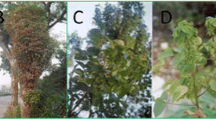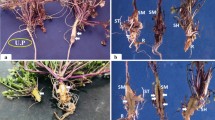Abstract
Pear leaf scorch, the only Xylella fastidiosa-induced disease reported from Taiwan, was found in area where the variety Hengshan (Pyrus pyrifolia) was grown. Strains of pear leaf scorch Xyl. fastidiosa (XF-PLS) shared similarities to strains of other host origins in the requirement of complex medium and the exhibition of rippled cell walls, however, recent serological and molecular biology studies showed difference among them. Five strains of XF-PLS were compared with 20 other strains originally isolated from almond, oleander, pecan, plum, peach, mulberry, grapes, citrus, coffee, and sycamore by sequence analyses of the 16S rRNA gene and 16S–23S rRNA internal transcribed spacer region (ITS). When sequences of 16S rRNA gene based on fragment size of 1,537–1,540 bp were compared, the similarity index among 5 XF-PLS strains was 99.3–99.8%, whereas it was 97.8–98.6% between XF-PLS strains and strains from other hosts. When sequences of 16S–23S rRNA ITS based on fragment size of 510–540 bp were compared, the similarity index among 5 XF-PLS strains was 99.0–100%, whereas it was 80.7–82% between XF-PLS strains and strains from other hosts. Multiple sequence alignments led to the identification of 5 polymorphic nucleotides in the 16S rRNA gene among the 25 Xyl. fastidiosa strains, and there were considerable variations in the nucleotide sequences of 16S–23S rRNA ITS between XF-PLS and the other 20 Xyl. fastidiosa strains. The phylogenetic trees revealed that XF-PLS strains were separated from strains of other hosts. Strains of other hosts were divided into four subgroups: strains from (1) oleander, (2) grape, almond M23 and mulberry, (3) citrus and coffee, and (4) pecan, peach, plum, sycamore and almond M12. Results indicate that XF-PLS strains were not closely related to the above-mentioned strains from other hosts and could possibly belong to a new subspecies of Xyl. fastidiosa.






Similar content being viewed by others
References
Altschul, S. F., Gish, W., Miller, W., Myers, E. W., & Lipman, D. J. (1990). Basic local alignment search tool. Journal of Molecular Biology, 215, 403–410.
Berisha, B., Chen, Y. D., Zhang, G. Y., Xu, B. Y., & Chen, T. A. (1998). Isolation of Pierce’s disease bacteria from grapevines in Europe. European Journal of Plant Pathology, 104, 427–433.
Chang, C. J., & Walker, J. T. (1988). Bacterial leaf scorch of northern red oak: isolation, cultivation, and pathogenicity of a xylem-limited bacterium. Plant Disease, 72, 730–733.
Chang, C. J., Ganier, M., Zreik, L., Rossetti, V., & Bove, J. M. (1993). Culture and serological detection of xylem-limited bacterium causing citrus variegated chlorosis and its identification as a strain of Xylella fastidiosa. Current Microbiology, 27, 137–142.
Chang, C. J., Donaldson, R., Brennen, P. M., Krewer, G., & Boland, B. (2009). Bacterial leaf scorch, a new blueberry disease caused by Xylella fastidiosa. Hortscience, 44, 413–417.
Chen, J., Chang, C. J., Jarret, R. L., & Gawel, N. (1992). Genetic variation among Xylella fastidiosa strains. Phytopathology, 82, 973–977.
Chen, J., Bank, D., Jarret, R. L., Chang, C. J., & Smith, B. J. (2000a). Use of 16S rDNA sequences as signature characters to identify Xylella fastidiosa. Current Microbiology, 40, 29–33.
Chen, J., Banks, D., Jarret, R. L., & Jones, J. B. (2000b). Evidence for conserved tRNA genes in the 16S–23S rDNA spacer sequence and two rrn operons of Xylella fastidiosa. Canadian Journal of Microbiology, 46, 1171–1175.
Chen, J., Jarret, R. L., Qin, X., Hartung, J. S., Banks, D., Chang, C. J., et al. (2000c). 16S rDNA sequence analysis of Xylella fastidiosa strains. Systematic and Applied Microbiology, 23, 349–354.
Chen, J., Hartung, J. S., Chang, C. J., & Vidaver, A. K. (2002). An evolutionary perspective of Pierce’s disease of grapevine, citrus variegated chlorosis, and mulberry leaf scorch diseases. Current Microbiology, 45, 423–428.
Chen, J., Groves, R., Civerolo, E. L., Viveros, M., Freeman, M., & Zheng, Y. (2005). Two Xylella fastidiosa genotypes associated with almond leaf scorch disease on the same location in California. Phytopathology, 95, 708–714.
Chen, J., Xie, G., Han, S., Chertkov, O., Sims, D., & Civerolo, E. L. (2010). Whole genome sequences of two Xylella fastidiosa strains (M12 and M23) causing almond leaf scorch disease in California. Journal of Bacteriology, 192, 4534.
Davis, M. J., Purcell, A. H., & Thomson, S. V. (1980). Isolation medium for the Pierce’s disease bacterium. Phytopatholgy, 70, 425–429.
Davis, M. J., French, W. J., & Schaad, N. W. (1981). Axenic culture of the bacteria associated with phony disease of peach and plum leaf scald. Current Microbiology, 6, 309–314.
Felsenstein, J. (2004). PHYLIP: Phylogeny inference package. Seattle: Department of Genome Sciences and Department of Biology, University of Washington.
Gendel, S. M. (1996). Computational analysis of the specificity of 16S rRNA-derived signature sequences for identifying food-related microbes. Food Microbiology, 13, 1–15.
Goncalves, E. R., & Rosato, Y. B. (2002). Phylogenetic analysis of Xanthomonas species based upon 16S–23S rDNA intergenic spacer sequences. International Journal of Systematic and Evolutionary Microbiology, 52, 355–361.
Hartung, J. S., Beretta, J., Brlansky, R. H., Spisso, J., & Lee, R. F. (1994). Citrus variegated chlorosis bacterium: axenic culture, pathogenicity, and serological relationships with other strains of Xylella fastidiosa. Phytopathology, 84, 591–597.
Hauben, L., Vauterin, L., Swings, J., & Moore, E. R. B. (1997). Comparison of 16S ribosomal DNA sequences of all Xanthomonas species. International Journal of Systematic Bacteriology, 47, 328–335.
Hendson, M., Purcell, A. H., Chen, D., Smart, C., Guilhabert, M., & Kirkpatrick, B. (2001). Genetic diversity of Pierce’s disease strains and other pathotypes of Xylella fastidiosa. Applied and Environmental Microbiology, 67, 895–903.
Hernandez-Martinez, R., de la Cerda, K., Costa, H. S., Cooksey, D. A., & Wong, F. P. (2007). Phylogenetic relationships of Xylella fastidiosa strains isolated from landscape ornamentals in southern California. Phytopathology, 97, 857–864.
Hillis, M. D., & Dixon, M. T. (1991). Ribosomal DNA: molecular evolution and phylogenetic inference. Quarterly Review of Biology, 66, 411–453.
Honeycutt, R. J., Sobral, B. W. S., & McClelland, M. (1995). tRNA intergenic spacers reveal polymorphisms diagnostic for Xanthomonas albilineans. Microbiology, 141, 3229–3239.
Hopkins, D. L. (1989). Xylella fastidiosa: xylem-limited bacterial pathogen of plants. Annual Review of Phytopathology, 27, 271–290.
Hopkins, D. L., & Adlerz, W. C. (1988). Natural hosts of Xylella fastidiosa in Florida. Plant Disease, 72, 429–431.
Hopkins, D. L., & Purcell, A. H. (2002). Xylella fastidiosa: cause of Pierce’s disease of grapevine and other emergent diseases. Plant Disease, 86, 1056–1066.
Jeannmougin, F., Thompson, J. D., Gouy, M., Higgins, D. G., & Gibson, T. J. (1998). Multiple sequence alignment with Clustal X. Trends in Biochemical Sciences, 23, 403–405.
Leu, L. S., & Su, C. C. (1993). Isolation, cultivation, and pathogenicity of Xylella fastidiosa, the causal bacterium of pear leaf scorch disease in Taiwan. Plant Disease, 77, 642–646.
Mehta, A., & Rosato, Y. B. (2001). Phylogenetic relationships of Xylella fastidiosa strains from different hosts, based on 16S rDNA and 16–23S intergenic spacer sequences. International Journal of Systematic and Evolutionary Microbiology, 51, 311–318.
Nathalie, L. B., Philippe, H., Vangin, I., & Decaris, B. (1996). 16S rRNA and 16S to 23S internal transcribed spacer sequence analyses reveal inter- and intra-specific Bifidobacterium phylogeny. International Journal of Systematic Bacteriology, 46, 102–111.
Neefs, J. M., Van de Peer, Y., De Rijk, P., Goris, A., & De Wachter, R. (1991). Compilation of small ribosomal subunit RNA sequences. Nucleic Acids Research, 19(Suppl), 1987–2015.
Page, R. D. (1996). TreeView: an application to display phylogenetic trees on personal computers. Computer Applications in the Biosciences, 12, 357–358.
Pooler, M. R., & Hartung, J. S. (1995). Genetic relationships among strains of Xylella fastidiosa from RAPD-PCR data. Current Microbiology, 31, 134–137.
Purcell, A. H., & Hopkins, D. L. (1996). Fastidious xylem-limited bacterial plant pathogens. Annual Review of Phytopathology, 34, 131–151.
Qin, X., Miranda, V. S., Machado, M. A., Lemos, E. G. M., & Hartung, J. S. (2001). An evaluation of the genetic diversity of Xylella fastidiosa isolated from diseased citrus and coffee in São Paulo, Brazil. Phytopathology, 91, 599–605.
Randall, J. J., Goldberg, N. P., Kemp, J. D., Radionenko, M., French, J. M., Olsen, M. W., et al. (2009). Genetic analysis of a novel Xylella fastidiosa subspecies found in the southwestern United States. Applied and Environmental Microbiology, 75, 5631–5638.
Rosato, Y. B., Neto, J. B., Miranda, V. S., Carlos, E. F., & Manfio, C. P. (1998). Diversity of a Xylella fastidiosa population isolated from Citrus sinensis affected by citrus variegated chlorosis in Brazil. Systematic and Applied Microbiology, 21, 593–598.
Sambrook, J., Fritsch, E. F., & Maniatis, T. (1989). Molecular cloning: A laboratory manual (2nd ed.). Cold Spring Harbor: Cold Spring Harbor Laboratory Press.
Schaad, N. W., Postnikova, E., Lacy, G., Fatmi, M., & Chang, C. J. (2004). Xylella fastidiosa subspecies: X. fastidiosa subsp. piercei, subsp. nov., X. fastidiosa subsp. multiplex subsp. nov., X. fastidiosa subsp. multiplex subsp. nov., and X. fastidiosa subsp. pauca subsp. nov. Systematic and Applied Microbiology, 27, 290–300.
Schreiber, H. L., IV, Koirala, M., Lara, A., Ojeda, M., Dowd, S. E., Bextine, B., et al. (2010). Unraveling the first Xylella fastidiosa subsp. fastidiosa genome from Texas. Southwestern Entomologist, 35, 479–483.
Schuenzel, E. L., Scally, M., Stouthamer, R., & Nunney, L. (2005). A multigene phylogenetic study of clonal diversity and divergence in north American strains of the plant pathogen Xylella fastidiosa. Applied and Environmental Microbiology, 71, 3832–3839.
Simpson, A. J., Reinach, F. C., Arruda, P., Abreu, F. A., Acencio, M., Alvarenga, R., et al. (2000). The genome sequence of the plant pathogen Xylella fastidiosa. Nature, 406, 151–157.
Smart, C. D., Schneider, B., Biomquist, C. L., Guerra, L. J., Harrison, N. A., Ahrens, U., et al. (1996). Phytoplasma-specific PCR primers based on sequences of the 16S–23S rRNA spacer region. Applied and Environmental Microbiology, 63, 2988–2993.
Stackebrandt, E., & Goebel, B. M. (1994). Taxonomic note: a place for DNA-DNA reassociation and 16S rRNA Sequence analysis in the present species definition in bacteriology. International Journal of Systematic Bacteriology, 44, 846–849.
Su, C. C., Yang, W. J., Feng, C. Y., Hsu, S. T., & Tzeng, K. C. (2008). The application of DNA fingerprintings amplified by arbitrary primers in differentiating pear leaf scorch bacterium from other Xylella fastidiosa strains. Plant Pathology Bulletin, 17, 261–269 (Chinese with English abstract).
Toth, I. K., Avrova, A. O., & Hyman, L. J. (2001). Rapid identification and differentiation of soft rot Erwinias by 16S–23S intergenic transcribed spacer-PCR and restriction fragment length polymorphism analyses. Applied and Environmental Microbiology, 67, 4070–4076.
Van Sluys, M. A., de Oliveira, M. C., Monteiro-Vitorello, C. B., Miyaki, C. Y., Furlan, L. R., Camargo, L. E., et al. (2003). Comparative analyses of the complete genome sequences of Pierce’s disease and citrus variegated chlorosis strains of Xylella fastidiosa. Journal of Bacteriology, 185, 1018–1026.
Vandamme, P., Pot, B., Gillis, M., de Vos, P., Kersters, K., & Swings, J. (1996). Polyphasic taxonomy, a consensus approach to bacterial systematics. Microbiological Reviews, 60, 407–438.
Weisburg, W. G., Barns, S. M., Pelletier, D. A., & Lane, D. J. (1991). 16S ribosomal DNA amplification for phylogenetic study. Journal of Bacteriology, 173, 697–703.
Wells, J. M., Raju, B. C., Hung, H.-Y., Weisburg, W. G., Mandelco-Paul, L., & Brenner, D. J. (1987). Xylella fastidiosa gen. nov., sp. nov: gram-negative, xylem-limited, fastidious plant bacteria related to Xanthomonas spp. International Journal of Systematic Bacteriology, 37, 136–143.
Acknowledgements
The authors would like to thank Mr. Che-Ming Chang for his assistance in phylogenetic analysis presented in Figs. 3 and 4. The research was funded by the Council of Agriculture grant 99AS-9.3.1-BQ-B2 to C.C.S. and W.L.D. and the National Science Council grants NSC 98-2811-B-005-044 and NSC100-2811-B-005-001to F.J.J. and C.J.C.
Author information
Authors and Affiliations
Corresponding authors
Additional information
Chiou-Chu Su and Chung-Jan Chang contributed equally to this work.
Rights and permissions
About this article
Cite this article
Su, CC., Chang, CJ., Yang, WJ. et al. Specific characters of 16S rRNA gene and 16S–23S rRNA internal transcribed spacer sequences of Xylella fastidiosa pear leaf scorch strains. Eur J Plant Pathol 132, 203–216 (2012). https://doi.org/10.1007/s10658-011-9863-6
Accepted:
Published:
Issue Date:
DOI: https://doi.org/10.1007/s10658-011-9863-6




